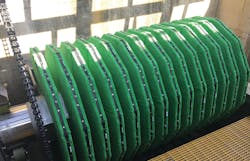Water Connections: Cloth Media Filter Treats CSO Discharge
The City of Rushville, Ind., had to remedy a consent order filed in 2007 for its untreated combined sewer overflow (CSO) discharges that were polluting the Flatrock River, a violation of the Clean Water Act. The city originally planned to install a 1 MGD stormwater storage tank but was approached by Aqua-Aerobic representatives with a pilot test proposal utilizing a new technology. The pilot proposal featured the AquaStorm™ Cloth Media Filter utilizing 5-micron microfiber cloth media, which would be tested during five wet weather events.
The study captured events from May to July 2015 and produced impressive results. The successful pilot test prompted the city to request a design for an AquaStorm filtration system in February 2016. The request came with two stipulations: the filters were to treat both dry and wet weather conditions, and alum coagulant was to be injected upstream of the filters to meet future effluent phosphorus limits and eliminate fine CSO particles.
Start-up of the two 14-disk AquaStorm filtration system began in July 2017 with a design average flow rate of 1 MGD in dry conditions and peak wet weather flow rate of 12.6 MGD. Each cloth media disk is 6.6 feet in diameter and provides an effective filtration area of 53.8 square feet, for a total filtration area of 1506.4 square feet. The filters were retrofitted into the plant’s existing, abandoned sand media filter structures, saving the city considerable capital costs. In addition, the new filtration system was $1 million less than the original, conventional storage tank design.
Rushville’s new tertiary/wet weather filtration system also included replacement of its existing gas chlorine disinfection system with a UV disinfection system. The UV system was installed in the existing tank, which also provided significant project cost savings.
Completion of the filtration/disinfection phase of the city’s upgrade project was achieved five years earlier than required by the state regulation agency. This project is the first AquaStorm filter installation in the nation for dual tertiary/wet weather treatment and will keep approximately 50 million gallons of raw sewage from entering the nearby Flatrock River annually.
“With the addition of the AquaStorm Filter System and new UV disinfection system, Rushville is discharging the best quality of water to our receiving stream, the Flatrock River, than in years past,” Utilities Director Les Day said.
The AquaStorm filter features a disk configuration and an outside-in flow path, which allows for three zones of solids removal. These zones are especially critical in wet weather applications due to the high solids typically associated with the first flush after wet weather events.
The top zone is the “floatable zone” where surface materials such as fats, oils and grease are allowed to collect on the water surface. Solids are removed from this zone by allowing floating material to overflow a scum weir a couple of times each day. The middle zone is the “filtration zone” where solids are removed through filtration. Here, solids deposit on the outside of the cloth media, forming a mat as filtrate flows through the media.
The buildup of solids on the media creates hydraulic resistance to flow through the media and causes the water level in the tank to rise. Once a predetermined liquid level or time setting is attained, the disks begin to rotate and the backwash pump starts, which draws filtered water from the inside of the disk through the media and removes solids from the filter media’s surface. This process fluidizes fibers to provide an efficient release of stored solids deep within the fiber. The bottom or “solids zone” permits heavier solids to settle to the bottom of the tank for intermittent removal. The solids are evacuated from the hopper through collection laterals using the solids/backwash pump. WW
Aqua-Aerobic Systems Inc. is exhibiting at WEFTEC.19, booth 2234. To learn more, visit www.aqua-aerobic.com.

